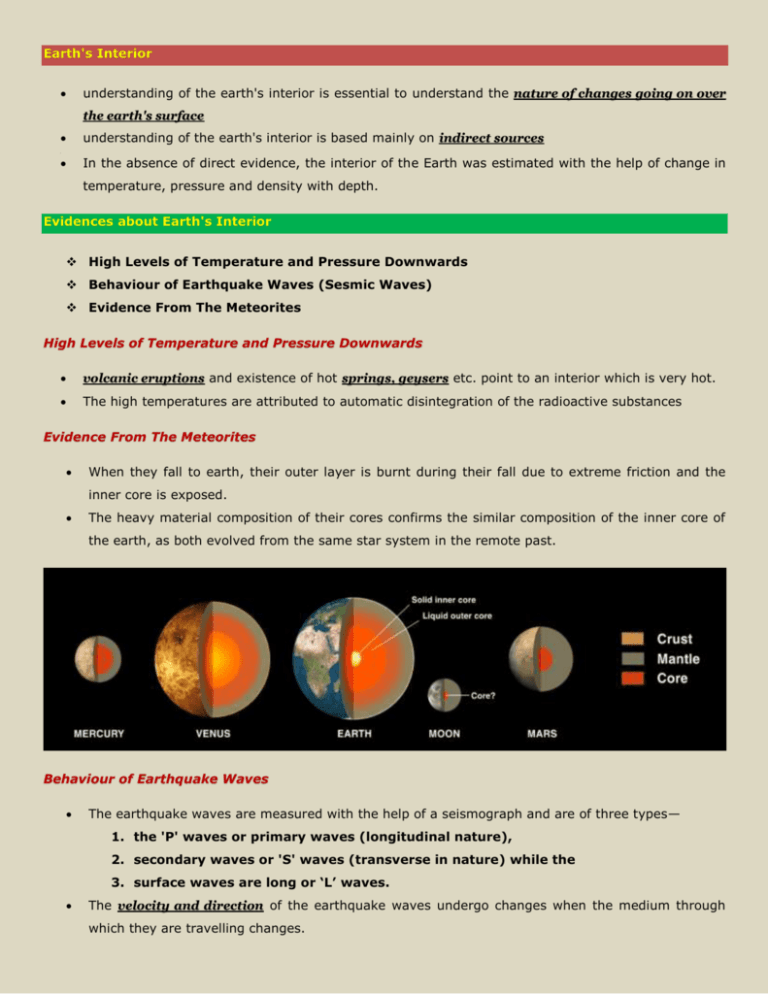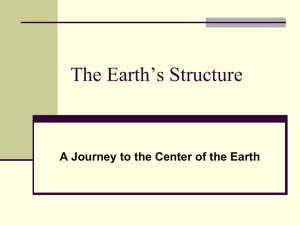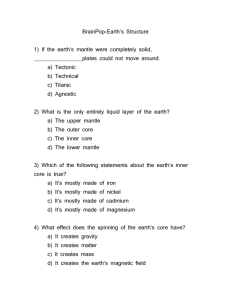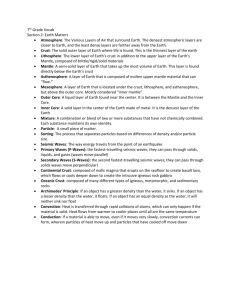Earth`s Interior
advertisement

Earth's Interior understanding of the earth's interior is essential to understand the nature of changes going on over the earth's surface understanding of the earth's interior is based mainly on indirect sources In the absence of direct evidence, the interior of the Earth was estimated with the help of change in temperature, pressure and density with depth. Evidences about Earth's Interior High Levels of Temperature and Pressure Downwards Behaviour of Earthquake Waves (Sesmic Waves) Evidence From The Meteorites High Levels of Temperature and Pressure Downwards volcanic eruptions and existence of hot springs, geysers etc. point to an interior which is very hot. The high temperatures are attributed to automatic disintegration of the radioactive substances Evidence From The Meteorites When they fall to earth, their outer layer is burnt during their fall due to extreme friction and the inner core is exposed. The heavy material composition of their cores confirms the similar composition of the inner core of the earth, as both evolved from the same star system in the remote past. Behaviour of Earthquake Waves The earthquake waves are measured with the help of a seismograph and are of three types— 1. the 'P' waves or primary waves (longitudinal nature), 2. secondary waves or 'S' waves (transverse in nature) while the 3. surface waves are long or ‘L’ waves. The velocity and direction of the earthquake waves undergo changes when the medium through which they are travelling changes. when an earthquake or underground nuclear test sends shock waves through the Earth, the cooler areas, which generally are rigid, transmit these waves at a higher velocity than the hotter areas. Primary Waves (P waves) also called as the longitudinal or compressional waves. In this type of wave motion, particles of the medium vibrate along the direction of propagation of the wave. These waves are of high frequency short wave length They can travel in both solids and liquids travels with fastest speed through solid and more dense materials In liquid materials, their speed is slowed down. velocity of P waves decreases towards the interior pointing to a less solid layer (a characteristic of longitudinal waves), but increase for a while when passing through the inner core only to decrease as it comes out of the core. This points to a solid core surrounded by a partially molten layer. Secondary Waves (S waves) also called as transverse or distortional waves. analogous to water ripples or light waves A secondary wave cannot pass through liquid materials. These waves are of high frequency, short wave-length waves travel at varying velocities (proportional to density) through the solid part of the Earth's crust, mantle and core. The shallow zone of 'S' waves extends almost halfway around the globe from the earthquake's focus. This proves that the outer core of the Earth is liquid. Since S waves cannot travel through liquid, they do not pass through the core. Surface Waves (L waves) Also long period waves. generally affect the surface of the Earth only and die out at smaller depth. The are low frequency, long wavelength, and transverse vibration develop in the immediate neighbourhood of the epicenter. These waves are responsible for most the destructive force of earthquake. recoded in the last at the seismograph. The L waves do not pass and do not go deeper inside the earth. Seismic Discontinuities 1. Mohorovicic Discontinuity (Moho) - separates the crust from the mantle, its average depth being about 35 km. 2. a soft asthenosphere (highly viscous, mechanically weak and ductile) 3. Gutenberg Discontinuity - lies between the mantle and the outer core. Below 2900 km from earth’s surface. Layers of the Earth The structure of the earth's interior is layered. It is made up of several concentric layers broadly three layers can be identified—crust, mantle and the core. Layers based on chemical properties (1) crust, (2) mantle, and (3) core. The Crust Crust is the outer thin layer with a total thickness of around 100 km. It forms 0.5-1.0 per cent of the earth's volume. part of the Earth above the Mohorovicic (Moho) discontinuity. The outer covering of the crust is of sedimentary material (granatic rocks) and below that lie crystalline, igneous and metamorphic rocks which are acidic in nature. The lower layer of the crust consists of basaltic and ultra-basic rocks The continents are composed of lighter silicates—silica + aluminium (also called `sial—while the oceans have the heavier silicates—silica + magnesium (also called `sima'), which form a part of the mantle. Mantle Moho-Discontinuity to the core. The depth of mantle varies between 35 km and 2900 km. The density varies between 2.9 and 3.3. The density ranges from 3.3 to 5.7 in the lower part. It is composed of solid rock and magma forms 16 per cent of the earth's volume. The outer layer of the mantle is partly simatic while the inner layer is composed of wholly simatic ultrabasic rocks. Core lies between 2900 km and 6400 km below the earth's surface accounts for 83 per cent of the earth's volume. core has the heaviest mineral materials of highest density. It is composed of nickel and iron [nife] The outer core is liquid while the inner core is solid. a zone of mixed heavy metals + silicates separates the core from outer layers.








